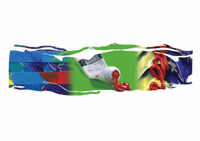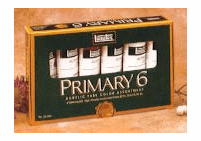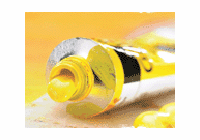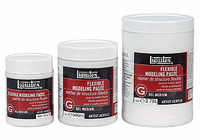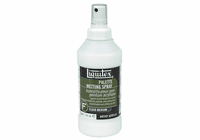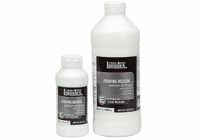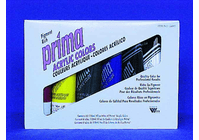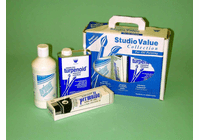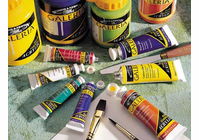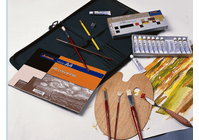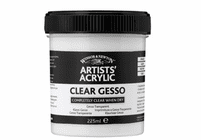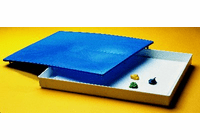ACRYLIC PAINTS

All of our acrylic paints conform fully to all U.S. Federal Safety Standards.
Scroll down for Tips on Acrylic Painting
For the professional artist, budding art student or hobbyist, quality acrylic paint makes the ultimate difference in the final results of your project. A demonstration of the paint's quality is achieved through its vividly intense pigments, the workable viscosity, its inherent integrity as well as its drying abilities. Paints that neither crack, chip nor retain a bubbled appearance are sought after by craftsman, artisans and masters alike. With a wide range of colorful options, Liquitex acrylics can exceed your wildest musings. With 249 tubes in each set, Liquitex acrylics maintain a rich, consistent and brilliant sheen without distracting uneveness when dried.
For your next masterpiece, think Liquitex.
Imagine the paintings, crafts and projects created with 249 acrylic paint tubes to choose from. A high quality array of vibrant pigments and textural consistency will produce the perfect blend for your shading, toning and tinting techniques. Water soluble formula makes clean up a breeze!
* * *QUESTiONS & ANSWERS / TIPS On ARTIST'S ACRYLIC PAINTS:
Acrylic Paint Mediums
What is an acrylic paint medium used for?
To change the consistency of your acrylic paints you will have to add mediums. If you want to be able to create textures or show off your brush strokes you will want to add a medium that will thicken your paint. To create washes of color you should add a medium that will thin your acrylic paint.
Applying Acrylic Paints To Your Canvas
How do you apply acrylic paint colors?
Acrylic paints are very versatile. You can use them in diluted form to achieve the watercolor fashion or you can use them in an opaque way. When you are working with transparent colors you should work from light to dark just like you would if you were painting with watercolors. Keep in mind that acrylic paints dry darker. This is different than watercolors which lighten as they dry.
Improving the Flow of Your Acrylic Paints
What does medium do when mixed with acrylic paints?
Do not assume that just because acrylic paint is water based that to increase the paint flow you would mix it with water. That is just not true. While adding water to your acrylic paint will increase its flow the depth of the color will be lost. To increase the flow of acrylic paint without losing its color you should use a medium that improves the flow. Do not use water unless you want to improve the flow and lighten the paint.
Mixing Acrylic Paint Colors
Is there a right way to mix acrylic paint colors?
When creating different shades with your paint you must work fast. The best method to mixing acrylic paint colors is to add dark colors to light colors. This method works because you will only need to add a small amount of dark paint to change the light paint to the color you desire. If you add the light paint to a dark color you will have to use a lot more paint.
Mixing Browns
How do you mix brows?
When it comes to mixing paint, browns and grays can be the most difficult. The best way to go about making these colors is to use the complementary colors that you are working with in your painting. For instance, if you are using blue in your painting try making brown by mixing orange with blue instead of mixing green and red.
The Environmental Impact of Acrylic Paints
How can I dispose of acrylic paints in an environmentally safe way?
Before you discard your paints, paper towels and old brushes you should allow them to thoroughly dry out first. This will lessen the risk that the paints will harm the environment when they reach the landfill.
The Frugal Acrylic Painter
How can I save money on acrylic paint supplies?
If you are looking for a cheap and useful household object to use for your palette, you should consider using plastic ice cube trays. It is easy to mix colors in an ice cube tray. To keep your paints fresh simply add a drop of water to each color and cover it with plastic wrap at the end of each day.
Acrylic paints
Why are acrylic colors best?
Acrylic paint colors are smooth and have a thick buttery consistency. They perform mulch like oil paints yet they are relatively easy to brush out. All acrylic paints are made to dry within a very tight satiny sheen range. This helps to reduce the chance that the colors in your painting will dry with different sheens such as matte, satin or gloss.
Acrylic Paints
Why do many artists prefer acrylic paint?
Acrylic paint is a fast dryer. You can dilute your acrylic paints in water and they will still be water resistant when they are dry. Depending upon how much water you use to dilute your acrylic paint will determine the finished look. It is important to note that many people use acrylic paints instead of watercolors simply because acrylics can resemble water colors -- yet they do not dry “light” like watercolors.
When using acrylics, always remember to clean your palette after painting to avoid a build-up of dry colour.
* * *
More Tips on Acrylic paints:
Another brand we use, which costs a bit less, is the Winsor & Newton GALERIA acrylics series. W&N is a world-class company in the art world and certainly need no introduction. One little, possibly less-known fact, is that LIQUITEX is also produced by W&N! They give you a choice between Liquitex and Galeria. An alternative company you might want to try, is Speedball. many of our students enjoy these. They have Gorgeous Colors and are also non-toxic. Speedball is a bit more economical too.
ACRYLIC "WATERCOLOR" TECHNIQUE: By thinning acrylics with a small quantity of water and acrylic medium, a paint that can be used like transparent watercolour is produced.
Comparison with watercolours
- Since acrylics are water-resistant when dry, they can be overpainted without disturbing previous colour.
- For the same reason, there is no need to frame an acrylic painting behind glass.
The Acrylic "Watercolor" Technique is done by thinning acrylics with a small quantity of water and acrylic medium, a paint that can be used like transparent watercolor is produced.
What you paint with acrylics on is as important as what you paint with. That being said, what can you paint acrylics on? Basically anything you want. Although more sturdy surfaces are preferred over lightweight papers.
If you do use paper, choose a heavier weight paper, so that it doesn't buckle and warp from the liquid (unless that is the desired effect, in which case, by all means go ahead!) Traditionally, paintings are done on wood, masonite, or canvas. Illustration board is also a very good alternative.

















